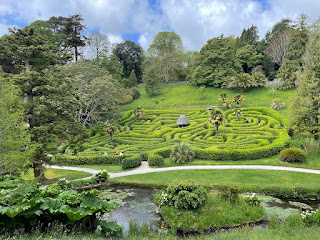There are some things in life that definitely look better in photos than they do in reality. Likewise, there are some things that look better in real life - most food, for example, doesn't photograph well unless you have professional lights and styling. Scones are obviously the exception - they always look great.
Anyway. Today I discovered that the extremely photogenic maze at Glendurgan Garden in Cornwall is ten times as impressive and astonishing in real life as it is in the photos. You have to go and see it for yourself - put it on your lists.
The Glendurgan Maze
Let's start with the maze. I'm sure everything else at Glendurgan gets fed up of playing second fiddle to it, but it's the star attraction for good reason:
The maze was built in 1833 by Alfred Fox to entertain his friends. He modelled it on the maze at Sydney Gardens in Bath, although that was built on flat ground.
The guidebook says "it looks like a tea plantation in Assam" and that is absolutely true. It also feels like a tea plantation in Assam - if you're over 4' tall, you'll be able to see over the hedges as you walk around. I was thinking 'I can see exactly where I'm going - how hard can this be??' except it was hard. I would suddenly come to an unexpected dead-end, and it didn't matter whether I could see over the hedge or not - I still had to go back. It was a really interesting experience.
I was also completely shocked by the final paragraph about the maze in the guide book: "In 1991 the Maze was in a really poor condition and a decision was taken to restore it. The hedges were cut to ground level, the path surfaces were reinstated and the summer house added. Although a difficult decision at the time it has resulted in a maze in very good health."
Can you EVEN IMAGINE being responsible for the decision to raze the Glendurgan maze to the ground? And then being the one to actually go in there with the chainsaw (OK - maybe they didn't use a chain saw)? There's a photograph of it in 1991 and it looks like a muddy field containing some very small rose bushes. National Trust gardeners have stronger nerves than me, that's for sure.
But there's more to Glendurgan than the maze. I'll start with some history:
- The garden was started by Alfred Fox in the 1830s.
- Alfred came from a wealthy Quaker family of ship agents - they were also keen gardeners.
- He built a thatched cottage on the estate in 1826 - apparently one day he was having lunch when he was informed that the cottage had burnt down. Rather than being annoyed, he took the opportunity to build a bigger house.
- His grandson, Cuthbert, decided to give the garden to the National Trust in 1962.
The other attractions include:
- The Holy Bank - there's a Victorian section of the garden containing appropriate plants, including a Judas tree, a Crown of Thorns and a Prickly Moses.
- Areas dedicated to New Zealand and Bhutan, as well as the Jungle, which contains giant rhubarb and banana leaves.
Durgan
At the bottom of Glendurgan Garden is a small former fishing village called Durgan. It's tiny - it mainly consists of National Trust holiday properties. But it's a beautiful spot with a little beach for a quiet change of scene.





No comments:
Post a Comment